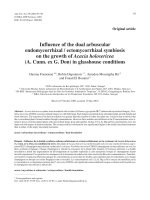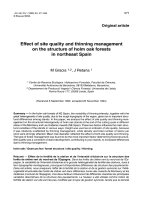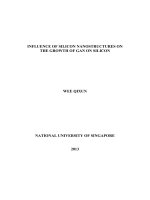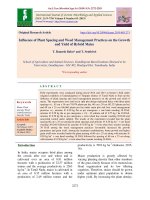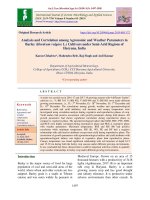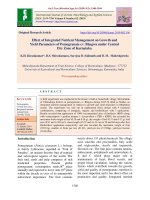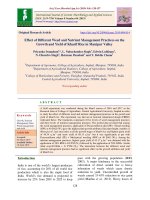Effect of weed and nutrient management on the growth and yield of barley (Hordeum vulgare L.) and associated weeds
Bạn đang xem bản rút gọn của tài liệu. Xem và tải ngay bản đầy đủ của tài liệu tại đây (290.47 KB, 9 trang )
Int.J.Curr.Microbiol.App.Sci (2019) 8(2): 993-1001
International Journal of Current Microbiology and Applied Sciences
ISSN: 2319-7706 Volume 8 Number 02 (2019)
Journal homepage:
Original Research Article
/>
Effect of Weed and Nutrient Management on the Growth and Yield of
Barley (Hordeum vulgare L.) and Associated Weeds
Santosh Kumar1*, Vivek1, N.S. Rana1, Ravindra Kumar2, R.K. Naresh1 and B.P. Dhyani3
1
Department of Agronomy, 2Department of Cell Biology, 3Department of Soil Science and
Agricultural Chemistry, Sardar Vallabhbhai Patel University of Agriculture & Technology
Meerut- 250110 (Uttar Pradesh), India
*Corresponding author
ABSTRACT
Keywords
Barley, N-PK,
Vermicompost,
FYM, Trisulfuron
15g a.i ha-1, Yield
Article Info
Accepted:
10 January 2019
Available Online:
10 February 2019
Barley is the most important food grain crop among cereals and stands next only to rice in
our country. It has significantly contributed in the success of the green revolution and has
greatly helped to transform our country from a situation of ship to mouth to being setsufficient. Barley is a good supplement for nutritional requirement of human body as it
contains 8-10% protein and 69.6% carbohydrates, 1.3% fat, 3.9% crude fiber. A field
experiment was conducted during 2015-16 and 2016-17at Crop Research Center, Sardar
Vallabhbhai Patel University of Agriculture and Technology, Meerut (U.P.). The
experiment was laid out in split-plot design with three replications. The rabi season
experiment comprised of five levels of nutrient viz.; 100% NPK, 75% N-PK + 25% N
through FYM, 75% N-PK + 25% N through vermicompost, 50% N-PK + 50% N through
FYM, 50% N-PK + 50% N through vermicompost and four levels of weed control
measures viz., Control, Two hand weeding, Trisulfuron 15g a.i ha-1 and Carfentrazone
ethyl 15g a.i ha-1. The plant height was significantly affected at 30, 60, 90 DAS and at
harvest in different treatments. The maximum plant height was recorded with the
application of 75% N-PK + 25% N through vermicompost which was significantly
superior to all other treatments during both years, the highest number of tillers per meter
row. Lowest number of tillers was recorded in 50% N-PK + 50% N through FYM. Weed
control treatments gave significantly higher yield attributes compared to control. Among
the herbicides Trisulfuron 15g a.i ha-1 was found more effective over Carfentrazone ethyl
15g a.i ha-1. Trisulfuron 15g a.i ha-1 was significantly effective and gave comparable
results to two hand weeding situation. Maximum number of spikelet per spike was
observed in two hand weeding and Trisulfuron 15g a.i ha-1 during both years.
cereals are less well adapted. It is a stable
food of the people in the Tibet, Nepal and
Bhutan. In European countries it is used only
as breakfast food. The leading countries of its
production are USSR, China, France, Canada,
Introduction
Barley is a major source of food for large
number of people living in the cooler semiarid areas of the world, where wheat and other
993
Int.J.Curr.Microbiol.App.Sci (2019) 8(2): 993-1001
USA and Spain. Barley is an important cereal
in India. Total area under barley in the
country is about 0.7 million hectares. The
chief barley growing regions in the country
are higher Himalayas, central parts of eastern
Uttar Pradesh, eastern parts of Rajasthan and
north western parts of north Bihar. The most
important uses of barley in India are as grain
feed to livestock and poultry, as malt for
manufacture of beer and other liquors like
whisky, brandy etc. As food barley flour is
used in preparing „chapatti‟. Sometimes
barley is mixed with gram or wheat and then
ground to flour for preparing better quantity
„chapati‟. Grain is roasted and ground and
used as „sattu‟ (barley flour mixed in sugar
and water). Grain is also broken and roughly
ground into „barley‟ to be used in soup.
Barley is a nutritious and easily digestible
cereal
with
8-10%
protein,
69.6%
carbohydrate, 1.3% fat, 3.9% crude fiber,
1.5% ash, 26 mg calcium, 215mg phosphorus,
1.2% minerals and 336 calorific value. It is
also rich in vitamin B complex and used to
prepare dishes like chapati, sattu etc. Globally
barley was cultivated on nearly 51.50 million
hectare area with a production of 142.01
million metric tons. In India, during 2016-17,
Barley occupied nearly 7.72 lakh hectare area
producing nearly 17.26 lakh tons grain, with a
productivity of 2522 kg/ha Anonymus,
(2017). The average productivity of barley in
the state is far behind the attainable yielding
of 40-50 q/ha Choudhary et al., (2014).
Problems further aggravated by weeds
compete is with the crop for moisture,
nutrients, space, light etc. Moreover they
increase production cost, decrease yield of the
crop, harbor insects and plant diseases,
decrease quality of farm produce and reduce
values of the land. The weed in India are
causing substantial losses to agriculture
production and the annual losses in terms of
money come to the Rs-1650 crores (Joshi,
2002) being higher than by insect‟s pests and
diseases. Hence, weed control is essential for
increasing barley production. It has been
reported that with production of each
kilogram of weed, one kilogram barley grains
are reduced (Chaudhary et al., 2008). The
problem of weed infestation has increased
manifold as it created favourable conditions
for invasion as well as luxuriant growth of
weeds particularly of Phalaris minor and
Avena spp. throughout barley growing area in
our country (Gill et al., 1984). Therefore,
cultural methods of weed control could not be
performed and becomes unaffordable. Plant
nutrition plays an important role in growth
and productivity of a crop. As barley crop is
highly responsive to applied nutrient through
various
sources,
a
proper
fertility
management is an important parameter for
optimizing the productivity of this crop. The
organic manures being cheaper and ecofriendly like FYM, compost, Vermicompost
with fertilizers is receiving great attention are
intensive agriculture. Application of organic
along with inorganic sources not only
improve soil health but with also improve the
produce quality and fertilizer use efficiency
and thereby reducing the cost of cultivation.
Use of organic manure have been found to be
promising m arresting the decline in
productivity through correction of secondary
and micronutrients deficiencies (Tripathi et
al., 2010).
Materials and Methods
The present research work was carried out at
the experimental field of Crop Research
Center, Sardar Vallabhbhai Patel University
of Agriculture and Technology, Meerut
(U.P.). During 2015-16 and 2016-17at with
RD-2035 variety of barley in a fourteen year
old The treatments comparing of combination
of five level of nutrient and four weed
management option where tested in Split-Plot
design with three replications, Inter Row
spacing 22.50 cm Nutrient management 100
% NPK, 75 % N-PK + 25 % N through FYM,
994
Int.J.Curr.Microbiol.App.Sci (2019) 8(2): 993-1001
75 % N-PK + 25 % N through vermicompost,
50 % N-PK + 50 % N through FYM, 50 % NPK + 50 % N through vermicompost and
Weed management practices Control, Two
hand weeding, Trisulfuron 15 g a.i ha-1,
Carfentazone ethyl 15 g a.i ha -1.The
experiment was conducted at (CRC) farm of
the University located in Indo-Gangetic plains
of Western Uttar Pradesh in Western plains
zone. The farm is geographically located at
290 04‟ 19” N latitude, 770 42‟ 50” E
longitudes and at an elevation of 237 metres
above the mean sea level. Soil samples were
collected to a depth of 0-15 cm from 10 spots
in the experimental field prior to sowing of
barley crop. The samples thus collected were
mixed homogenously and a composite sample
was drawn for analyzing various physicochemical properties. The soil of experimental
site was sandy loam in texture, low in organic
carbon and nitrogen and medium in available
phosphorus and available potassium and
neutral in reaction. Such as Organic carbon
(%) (Walkey and Black‟s (1947), total
nitrogen (kg/ha.) by Alkaline permanganate
method (Subhaiah Asija, 1956), phosphorus
(kg/ha.) by Olsen‟s Calorimetric Method
(Olsen et al., 1954), and potassium (kg/ha.)
by Flame Photometric Method (Toth and
Prince, 1949).
harvested at full maturity to record the data on
grain and straw yields. The data was analyzed
statistically.
Results and Discussion
Weed growth
The most commonly surveyed weeds in the
experimental situations through the two
growing seasons were: Grassy weeds Wild
oat (Avena ludoviciana, L.), Little seed
canary-grass (Phalaris minor L.) and Nongrassy weeds Blue or Scarlet pimpernel
(Anagallis arvensis L.), Common lambs
quarters (Chenopodium album L.), Yellow
sweet clover (Melilotus indica, L.), White
sweet clover (Melilotus alba L.), Fumitory
(Fumaria parviflora L.) and Sedges weeds.
Effect of nutrient managements
Nutrient and weed management practices both
had significant effect on dry matter
accumulation of total weeds at all the crop
stages during both years. The highest total
weeds dry matter accumulated where crop
was grown with 50% N-PK + 50% N through
FYM application during both the years (Table
1). Application of 75% N-PK + 25% N
through vermicompost led to significantly
reduction in total weeds dry matter
accumulation irrespective of the crop growth
stages during both years except at 30 DAS
during 2015-16. Mean reduction against
control was 27.02, 27.12 and 27.09 per cent,
respectively at 30, 60 and 90 DAS stages
Soil pH and EC measured by Digital pH
meter and conductivity meter respectively.
The requisite agronomic and plant protection
measures were adopted uniformly for all the
treatments during the entire growing period.
At maturity, data on plant characters and yield
components were recorded from five
randomly selected plants in each plot. The
growth and yield characters were recorded
such as plant height at harvest (cm), number
of total tillers plant-1, spike length (cm),
number of spike lets spike-1, number of
grains spike-1, 1000-seed weight (g), grain
yield (t ha-1), straw yield (t ha-1), and harvest
index (%). The crop from each unit plot was
Effect of weed managements
All the weed control measures reduced dry
matter accumulation of total weeds
significantly all the crop growth stage during
both years (Table 1). Among the herbicides
Trisulfuron 15g a.i ha-1 gave significantly
better control of dry matter accumulation of
995
Int.J.Curr.Microbiol.App.Sci (2019) 8(2): 993-1001
total weeds 60 and 90 DAS stages followed
by Carfentrazone ethyl 15g a.i ha-1 during
both years. At 90 DAS the mean reduction in
dry matter accumulation of total weeds was
73.13, 63.91, and 58.94 per cent, respectively
with two hand weeding, Trisulfuron 15g a.i
ha-1, and Carfentrazone ethyl 15g a.i ha-1
against control treatment. Total dry matter
reduction of weeds was significant amongst
the herbicidal treatment. Trisulfuron 15g a.i
ha-1 resulted in maximum dry matter reduction
and the results obtained under these
treatments. The reduction in dry matter of
weeds was because of effective control of
weeds by these herbicides.
resulted significant reduction in plant height
than rest of the treatments at all the growth
stages. Such a higher plant height in 75% NPK + 25% N through vermicompost can be
associated with sufficient nutrient supply at
the active growth stage. Similar results of
increased plant height were also reported by
Ram and Mir (2006); Singh et al., (2007);
Singh et al., (2008) and Singh and Pal (2011).
Effect of weed managements
Growth of barley plant in terms of plant
height, number of tillers per running meter
and dry matter accumulation reflects a
significant improvement under different weed
control treatments as compared to the control.
This remarkable improvement in crop growth
and development can be accounted on
reduced crop weed competition. Trisulfuron
15g a.i ha-1 was the best treatment for weed
control during both years which resulted in
maximum availability of moisture, nutrient,
light and space to the crop. These results are
in conformity with findings of Dixit and
Singh (2008); Singh et al., (2010) and
Barthwal et al., (2013).
Dry matter accumulation of weeds viz.;
Phalaris
minor,
Avena
ludoviciana,
Chenopodium album, Angallis arvensis,
Melilotus indica and others weeds were
significant effect on weed control measures
(Table 1). The significantly higher dry matter
accumulation was found under control and it
increase up to 60 DAS and their after
reduction was observed. Among the
herbicides Trisulfuron 15g a.i ha-1 gave best
control of dry matter of weeds followed by
Carfentrazone ethyl 15g a.i ha-1. These results
are in close conformity with reports of (Singh
et al., 2010).
Barley yield and its attributes
Effect of nutrient management
Barley growth
The number of tillers (Table 3) increased up
to at 60 DAS and started declining their after
at 90 DAS and at harvest. The highest number
of tillers per meter row was recorded in 75%
N-PK + 25% N through vermicompost
followed by 100% NPK. Lowest number of
tillers was recorded in 50% N-PK + 50% N
through FYM plots at 30, 60, 90 DAS and
harvest. Such a higher number of tillers in
these treatments can be linked with optimum
supply of essential nutrients at active tillering
stage. Similar results were also reported by
Pandey et al., (2009); Usadadiya and Patel
(2013) and Jat et al., (2013).
Effect of nutrient management
Plant height (Table 2) increased at a faster
rate during at 60 to 90 DAS was significantly
affected by different nutrients treatments. The
plant height was significantly affected at 30,
60, 90 DAS and at harvest in different
treatments. The maximum plant height was
recorded with the application of 75% N-PK +
25% N through vermicompost which was
significantly superior to all other treatments
during both years, except at 30 DAS. The
50% N-PK + 50% N through FYM plots
996
Int.J.Curr.Microbiol.App.Sci (2019) 8(2): 993-1001
Table.1 Effect of nutrient and weed management practices on dry weight of total weed (g m-2) in
barley at different stages
Treatment
Nutrient management
100% NPK
75% N-PK + 25% N through FYM
75% N-PK + 25% N through vermicompost
50% N-PK + 50% N through FYM
50% N-PK + 50% N through vermicompost
SEm(±)
C.D. (P=0.05)
Weed management
Control
Two hand weeding
Trisulfuron 15g a.i ha-1
Carfentrazone ethyl 15g a.i ha-1
SEm(±)
C.D. (P=0.05)
Dry weight of total weed (g m-2)
30 DAS
60 DAS
90 DAS
2015-16
2016-17
2015-16
2016-17
2015-16
2016-17
5.4
(28.7)
5.6
(31.1)
5.2
(26.2)
6.0
(35.9)
5.9
(35.0)
0.02
0.07
5.8
(33.8)
6.1
(36.6)
5.6
(30.8)
6.5
(42.2)
6.4
(41.2)
0.02
0.08
6.8
(46.5)
7.1
(50.4)
6.5
(42.4)
7.6
(58.2)
7.5
(56.7)
0.03
0.11
7.5
(56.3)
7.8
(61.0)
7.2
(51.4)
8.4
(70.5)
8.3
(68.7)
0.04
0.12
7.1
(49.9)
7.4
(54.1)
6.8
(45.5)
7.9
(62.4)
7.8
(60.8)
0.04
0.11
7.7
(59.3)
8.0
(64.2)
7.4 (54.1)
6.2
(38.5)
4.8
(22.5)
5.5
(30.2)
5.9
(34.4)
0.02
0.05
6.8
(45.3)
5.2
(26.5)
6.0
(35.5)
6.4
(40.4)
0.02
0.06
13.5
(182.2)
6.1
(36.4)
7.0
(48.9)
7.5
(55.7)
0.03
0.08
13.8
(192.1)
6.7
(44.1)
7.7
(59.2)
8.2
(67.4)
0.03
0.09
12.4
(153.5)
6.3
(39.0)
7.3
(52.4)
7.7
(59.6)
0.03
0.08
12.8
(164.4)
6.8
(46.4)
7.9
(62.3)
8.4
(70.9)
0.03
0.09
8.6
(74.2)
8.5
(72.3)
0.04
0.12
Table.2 Effect of weed management and nutrient management on plant height (cm) of barley
Treatment
Nutrient management
100% NPK
75% N-PK + 25% N through FYM
75% N-PK + 25% N through vermicompost
50% N-PK + 50% N through FYM
50% N-PK + 50% N through vermicompost
SEm(±)
C.D. (P=0.05)
Weed management
Control
Two hand weeding
Trisulfuron 15g a.i ha-1
Carfentrazone ethyl 15g a.i ha-1
SEm(±)
C.D. (P=0.05)
30 DAS
2015- 201616
17
Plant height (cm)
60 DAS
90 DAS
2015- 2016- 2015- 201616
17
16
17
At harvest
2015- 201616
17
19.80
18.51
21.65
17.65
18.28
0.34
1.12
17.35
16.22
17.79
15.46
16.02
0.67
1.65
49.45
46.24
55.81
44.09
45.67
0.95
3.08
43.33
40.54
49.00
38.61
40.03
0.88
2.87
71.81
67.13
80.97
64.04
66.31
1.34
4.37
58.26
54.43
65.57
51.93
53.84
0.94
3.08
90.04
85.71
93.44
82.27
85.63
1.68
5.47
85.54
81.43
88.77
78.16
81.35
1.60
5.20
18.65
19.71
19.48
18.86
0.28
0.81
16.50
17.38
17.25
16.59
0.52
1.30
47.04
49.53
49.16
47.28
0.59
1.72
41.24
43.42
43.12
41.44
0.58
1.68
68.29
71.91
71.35
68.66
0.83
2.40
55.41
58.28
57.88
55.65
0.70
2.01
70.02
95.19
93.22
91.24
1.37
3.96
66.52
90.44
88.56
86.68
1.30
3.76
997
Int.J.Curr.Microbiol.App.Sci (2019) 8(2): 993-1001
Table.3 Effect of weed management and nutrient management on number of tillers (m-1 row
length) of barley
Treatment
Nutrient management
100% NPK
75% N-PK + 25% N through FYM
75% N-PK + 25% N through
vermicompost
50% N-PK + 50% N through FYM
50% N-PK + 50% N through
vermicompost
SEm(±)
C.D. (P=0.05)
Weed management
Control
Two hand weeding
Trisulfuron 15g a.i ha-1
Carfentrazone ethyl 15g a.i ha-1
SEm(±)
C.D. (P=0.05)
Number of tillers (m-1 row length)
30 DAS
60 DAS
90 DAS
At harvest
2015- 2016- 2015- 2016- 2015- 2016- 2015- 201616
17
16
17
16
17
16
17
51.3
50.4
53.5
48.7
48.3
50.8
75.6
71.9
77.6
71.9
68.3
73.8
83.7
80.5
85.8
79.5
76.5
81.5
81.9
78.9
83.8
78.6
75.7
80.6
46.8
48.1
44.5
45.7
68.8
69.8
65.4
66.3
76.4
78.8
72.5
74.9
74.8
76.7
71.8
73.7
0.95
3.09
1.03
3.35
1.40
4.56
1.33
4.34
1.58
5.16
1.50
4.90
1.55
5.06
1.49
4.86
41.4
53.8
52.8
51.9
0.78
2.26
39.5
51.3
50.2
49.4
0.76
2.21
58.9
79.0
77.7
75.5
1.14
3.28
55.9
75.1
73.8
71.7
1.08
3.12
56.6
91.2
89.4
86.9
1.27
3.68
53.7
86.6
84.9
82.6
1.21
3.49
54.9
89.4
87.6
85.1
1.24
3.59
52.7
85.8
84.1
81.7
1.19
3.45
Table.4 Effect of weed management and nutrient management on spike length (cm), no. of
spikelets/spike, no. of grain/spike and test weight (g) of barley
Treatment
Nutrient management
100% NPK
75% N-PK + 25% N through FYM
75% N-PK + 25% N through
vermicompost
50% N-PK + 50% N through FYM
50% N-PK + 50% N through
vermicompost
SEm(±)
C.D. (P=0.05)
Weed management
Control
Two hand weeding
Trisulfuron 15g a.i ha-1
Carfentrazone ethyl 15g a.i ha-1
SEm(±)
C.D. (P=0.05)
Spike length
(cm)
2015- 201616
17
No. of
spikelets/spike
2015- 201616
17
No. of
grain/spike
2015- 201616
17
Test weight
(g)
2015- 201616
17
9.7
9.3
10.5
9.5
9.4
10.5
12.5
11.2
13.7
11.2
10.1
12.5
39.9
37.4
41.9
38.3
35.8
39.7
40.6
38.9
41.4
38.6
36.8
38.9
8.9
8.7
9.1
9.3
9.7
10.4
8.9
9.6
35.4
35.3
32.9
32.8
37.6
38.7
34.7
35.6
0.16
0.53
0.13
0.44
0.16
0.51
0.13
0.43
0.43
1.40
0.33
1.12
0.15
0.50
0.17
0.57
7.5
10.6
10.1
9.5
0.13
0.38
8.3
10.9
10.0
9.1
0.18
0.54
9.3
13.9
12.2
10.6
0.09
0.27
8.4
12.7
11.1
9.7
0.08
0.25
34.5
40.6
39.1
37.8
0.42
1.24
33.7
38.1
36.5
35.3
0.34
0.98
36.9
41.3
40.3
39.3
0.23
0.66
34.6
38.8
37.6
36.7
0.25
0.71
998
Int.J.Curr.Microbiol.App.Sci (2019) 8(2): 993-1001
The beneficial effect of organic manures on
grain, straw, biological yields and yield
attributing characters might be assigned to the
fact that after proper decomposition and
mineralization, these manures supplied
available plant nutrients directly to the plants
and also had solubilising effect on fixed forms
of nutrients in soil. Similar findings were also
reported by (Mubarak and Singh, 2011). The
combination use of organic manures and
chemical fertilizers enhanced the inherent
capacity of soil as reported by Pandey et al.,
(2009); Verma and Mathur (2009); Verma, et
al., (2010) and Meena et al., (2012).
It is concluded that the adoption of 75% NPK + 25% N through vermicompost
significantly improved the growth, yield
attributing characters, yield and productivity
of barley crop. Application of 100% NPK
gave at par results for these parameters.
Among the weed control practices Trisulfuron
15g a.i ha-1 improved the different growth
parameters and yield of barley crop over the
control.
Acknowledgement
Studentship support, provided by Department
of Agronomy, college of Agricultural, Sardar
Vallabhbhai Patel University of Agriculture &
Technology Meerut to conduct present
research work as part of Ph.D (Agronomy)
thesis, is duly acknowledged.
Effect of weed managements
Increase in spike length in two hand weeding
was 41.6 and 31.17 per cent (Table 4) over
the control during 2015-16 and 2016-17
respectively, followed by Trisulfuron 15g a.i
ha-1 and Carfentrazone ethyl 15g a.i ha-1 was
significantly higher over control.
References
Anonymous (2016-17) Agricultural Statistics
Division. New Delhi.
Barthwal, A., Bhardwaj, A.K., Chaturvedi, S.
and Pandiaraj, T. 2013. Site specific
NPK recommendation in wheat
(Triticum aestivum) for sustained crop
and soil productivity in mollisols of
Tarai region. Indian Journal of
Agronomy 58 (2): 208-214.
Chopra, N.K., Chopra, N. and Sinha 2008.
Influence of new broadleaf herbicides
on weed control, seed yield and quality
of some wheat (Triticum aestivum)
cultivars. Indian Journal of Agriculture
Science 78 (5): 405-407.
Chaudhary, S.U., M. Hussain, M.A. Ali and J.
Iqbal. 2008. Effect of weed competition
period on yield and yield components of
wheat Indian Journal of Agriculture
research.. 46: 47-53.
Choudhary, S., Yadav, L.R., Shivran, A.C.
and Puniya, M.M. (2014) Effect of
fertilizers and manures with foliar
application of iron on barley (Hordeum
Maximum number of spikelet per spike was
observed in two hand weeding 13.97 and
12.67 during both years followed by
Trisulfuron 15g a.i ha-1 during 2015-16 and
2016-17. Highest grains per spike and test
weight was observed in two hand weeding
40.60 and 38.12 and 41.33 and 38.79 g
followed by Trisulfuron 15g a.i ha-1 and
significantly superior to control during both
years. Similar finding were also reported by
Chopra et al., (2008). The harvest index was
significantly higher in two hand weeding
(42.06 and 39.46) followed by Trisulfuron
15g a.i ha-1 and Carfentrazone ethyl 15g a.i
ha-1 during 2015-16 and 2016-17. The better
performance of these treatments in terms of
yield could be attributes to better expression
of their yield attributes due to reduction in
crop weed competition. This could be
attributed to the selectivity of these herbicides
to crop and significantly effect on weeds has
already been reported Dixit and Singh (2008).
999
Int.J.Curr.Microbiol.App.Sci (2019) 8(2): 993-1001
vulgare L.). Green Farming, 5 (1): 4145
Dixit, A. and Singh, V.P. 2008. Efficacy of a
ready mix application of carfentrazone
plus, isoproturon (affinity) to control
weed in wheat (Triticum aestivum).
Indian Journal of Agriculture Science
78:6 495-497.
Gill, H.S., Singh, Ajmer and Walia, U.S.
1984. Tolerance of weed cultivars to
metoxuron. Indian Journal of weed
science 16: 176-181.
Jat, G., Majumdar, Jat, S.P., N.K. and
Majundar, S.P. 2013. Potassium and
zinc fertilization of wheat (Triticum
aestvum) in Western arid zone of India.
Indian Journal of Agronomy 58 (1) 6771.
Joshi, N. C.2002. “Manual of weed control”.
Research publication 7615-B, East
Azad nagar, Delhi-110 051.
Meena, B.L., Phogat, B.S., Jat, S.L., Singh,
A.K. and Sharma, H.B. 2012. Effects of
planting and integrated nutrient
management systems on root phenology
and grain yield of wheat. Etennded
Summaries: 3rd International Agronomy
Congress, Nov. 26-30, New Delhi,
India.
Pandey, I.B., Dwivedi, D.K. and Pandey,
R.K.
2009.
Integrated
nutrient
management for sustaining wheat
(Triticum aestivum) production under
late sown condition. Indian Journal of
Agronomy 54 (3): 306-309.
Ram T. and Mir, M.S. 2006. Effect of
integrated nutrient management on yield
and yield attributing characters of wheat
(Triticum aestivum). Indian Journal of
Agronomy 31 (3): 189-192.
Singh, R.K., Singh, S.K. and Singh, L.B.
2007. Integrated nitrogen management
in wheat (Triticum aestivum). Indian
Journal of Agronomy 52 (2): 124-126.
Singh, F., Kumar, R. and Pal, S. 2008.
Integrated nutrient management in rice-
wheat cropping system for sustainable
productivity. Journal of the Indian
Society of Soil Science vol. 56, No.2, pp
205-208.
Singh, Samunder, Ashok, Yadav, S.S. Punia,
R.S. Malik and R.S. Balyan 2010.
Interaction of stage of application and
herbicides on some Phalaris minor
populations. Indian Journal of Weed
Science 42: 144-154.
Singh, Samunder, Ashok, Yadav, S.S. Punia,
R.S. Malik and R.S. Balyan 2010.
Interaction of stage of application and
herbicides on some Phalaris minor
populations. Indian Journal of Weed
Science 42: 144-154.
Singh, Samunder., S.S. Punia., Ashok Yadav
and V.S. Hooda 2011. Evaluation of
carfentrazone-ethyl+metsulfuronmethyl against broadleaf weeds of
wheat. Indian Journal of Weed Science
43 (1&2): 12-22.
Subbiah, B.V. and Asija, G.L. 1956. A rapid
procedure for the estimation of
available Nitrogen in soil, curr. Sci
25:255-260.
Toth, S.J., and Prince, A.L. 1949. Estimation
of cation exchange capacity and
exchangeable Ca, K and Na contains of
soil by Flame Photometer. Soil Sci.,
67:430-445.
Tripathi, M.K., Chaturvedi, S., Shukla, D.K.
and Mahapatra, B.S. 2010.yield
performance and quality in Indian
mustard (Brassica juncia) as affected by
integrated nutrient management. Indian
Journal of Agronomy 55 (2): 138-142.
Usadadiya, V.P. and Patel, R.H. 2013.
Influence of preceding crops and
nutrient management on productivity of
wheat
(Triticum
aestivum)-based
cropping system. Indian Journal of
Agronomy 85 (1): 15-18.
Verma, G. and Mathur, A.K. 2009. Effect of
integrated nutrient management on
active pools of soil organic matter under
1000
Int.J.Curr.Microbiol.App.Sci (2019) 8(2): 993-1001
maize-wheat system of a Typic
Haplustept. Journal of the Indian
Society of Soil Science 57 (3) pp 317322.
Verma, G., Mathur, A.K., Bhandari, S.C. and
Kanthaliya, P.C. 2010. Long term effect
of integrated nutrient management on
properties of a typichaplustept under
maize-wheat cropping system.Journal
of the Indian society of soil science, vol,
58(3): 299-302.
Walkey, A. and Black, I.A. 1934. An
examination of the digital jar if
method/determining soil organic matter
and a proposal modification of the
Chromic Titration Method. Soil Sci.,
37:29-38.
How to cite this article:
Santosh Kumar, Vivek, N.S. Rana, Ravindra Kumar, R.K. Naresh and Dhyani, B.P. 2019.
Effect of Weed and Nutrient Management on the Growth and Yield of Barley (Hordeum
vulgare L.) and Associated Weeds. Int.J.Curr.Microbiol.App.Sci. 8(02): 993-1001.
doi: />
1001
